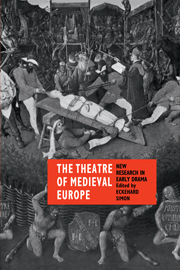Book contents
- Frontmatter
- Contents
- List of contributors
- Preface
- Note on the bibliography and system of references
- List of abbreviations for journals and series
- 1 Introduction: trends in international drama research
- PART I LATIN DRAMA
- PART II ENGLISH DRAMA
- PART III CONTINENTAL DRAMA
- 9 France
- 10 Italy: liturgy and christocentric spirituality
- 11 Spain: Catalan and Castilian drama
- 12 Germany and German-speaking central Europe
- 13 The Low Countries
- Bibliography
- Author index to the bibliography
- General index
13 - The Low Countries
Published online by Cambridge University Press: 29 March 2011
- Frontmatter
- Contents
- List of contributors
- Preface
- Note on the bibliography and system of references
- List of abbreviations for journals and series
- 1 Introduction: trends in international drama research
- PART I LATIN DRAMA
- PART II ENGLISH DRAMA
- PART III CONTINENTAL DRAMA
- 9 France
- 10 Italy: liturgy and christocentric spirituality
- 11 Spain: Catalan and Castilian drama
- 12 Germany and German-speaking central Europe
- 13 The Low Countries
- Bibliography
- Author index to the bibliography
- General index
Summary
INTRODUCTION
The drama with which this chapter concerns itself is that of the Dutch-speaking areas of the medieval Low Countries, which in modern terms means the medieval and sixteenth-century drama of the present-day Netherlands and the provinces of Flanders, Brabant and Limburg of present-day Belgium. The interest in and the study of medieval literature in the two countries, which share their medieval heritage, did not develop at the same pace and in the same way. In Belgium, the 1830s saw the rise of an antiquarian, Romantic interest in the Middle Ages, fostered by the Flemish Movement, a cultural and later political expression of pride in the language and literature of the Dutch-speaking population.
Since the split of the Low Countries at the end of the sixteenth century, Dutch-speakers in Belgium had been a culturally and economically depressed majority. In the wake of the Romantic Movement, renewed interest in and study of what came to be perceived as a glorious era in art and literature grew rapidly. Medieval studies in the Netherlands and Belgium today draw upon the remarkably extensive collections of documents and texts which were brought to light in the process. A considerable debt of gratitude goes to German scholars, such as Hoffmann von Fallersleben, for their early collections and studies concerning medieval history and literature.
- Type
- Chapter
- Information
- The Theatre of Medieval EuropeNew Research in Early Drama, pp. 225 - 252Publisher: Cambridge University PressPrint publication year: 1991
- 1
- Cited by

